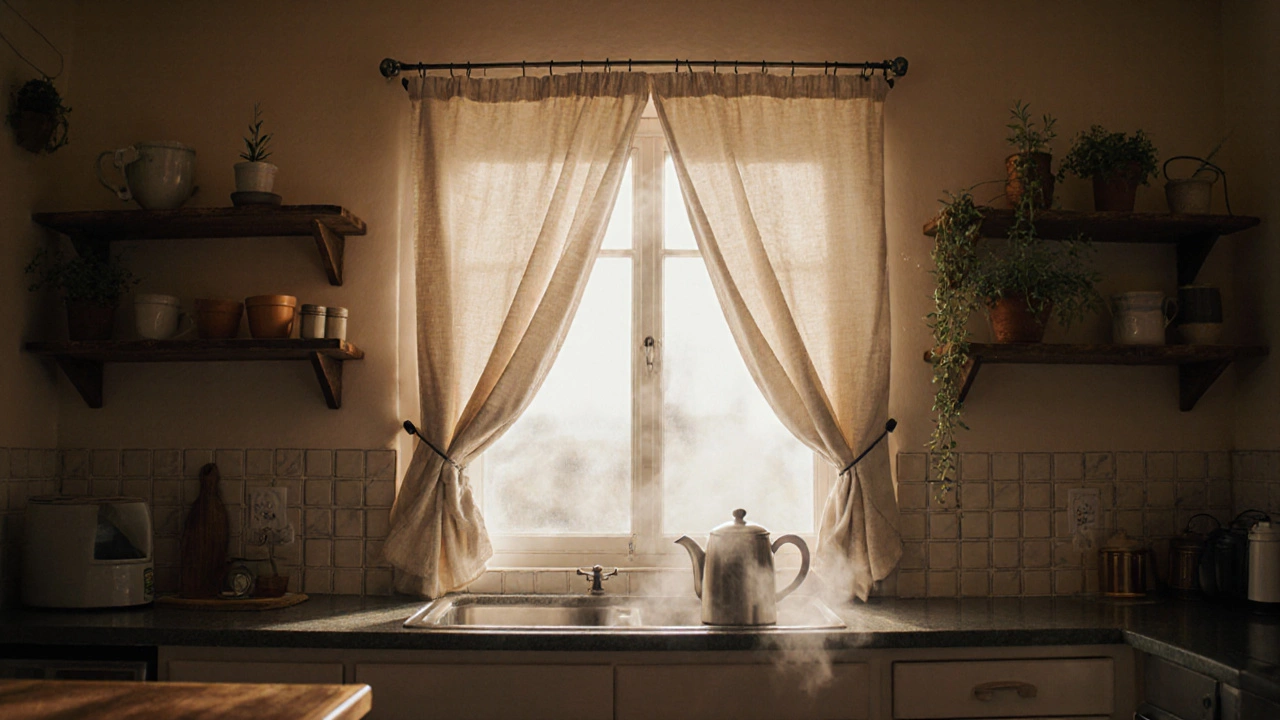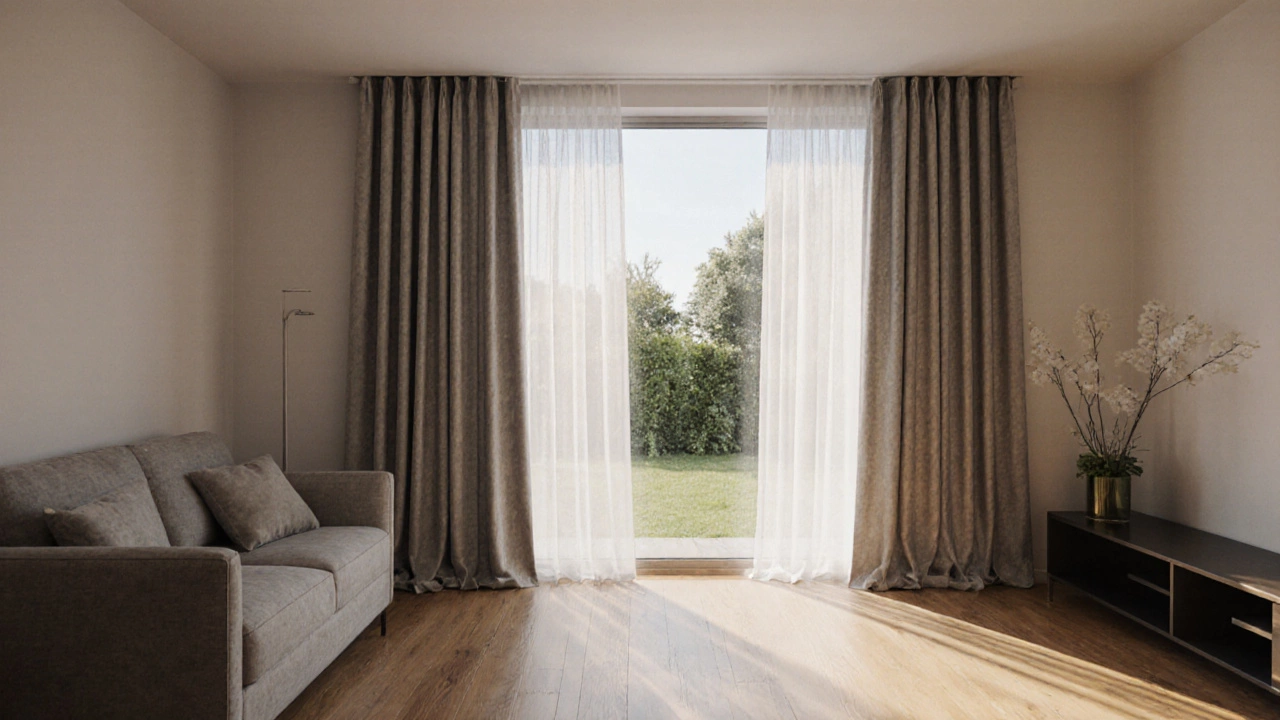Curtain Length Calculator
Calculate the perfect curtain length for your space based on room type, floor type, and desired style. The most common recommendation is 1/2 inch above the floor for most rooms.
Pro Tip:
Always measure from the top of your curtain rod, not the window frame. For sliding doors, extend the rod 6-12 inches beyond the frame for best appearance.
Ever pulled back your curtains and noticed they’re dragging on the floor like a muddy train? Or worse-hovering awkwardly above it, leaving a weird gap that breaks the whole look? Getting curtain length right isn’t just about style. It’s about function, safety, and making your room feel polished. The truth is, there’s no single answer to "how close to the floor should curtains hang?" It depends on the room, the style you want, and even the type of floor you have.
Standard Curtain Length: Just Above the Floor
The most common and safest choice is for curtains to hang 1/2 inch to 1 inch above the floor. This works for almost every home, especially if you have carpet, rugs, or uneven flooring. It keeps the fabric from catching on shoes, vacuum cleaners, or pet paws. It also makes cleaning under the curtains easy-no more scraping dust bunnies out from under fabric that’s touching the ground.
This length is what most ready-made curtain panels are cut to. If you buy curtains labeled "floor length," they’re usually designed to stop right before the floor. It’s the go-to for modern, minimalist, and traditional interiors alike. It gives the illusion of height without the mess.
For a Dramatic Look: Pooling Curtains
If you love the look of luxury hotels or old-world estates, you might want curtains that actually touch the floor and create a soft pool of fabric. This is called "pooling." It’s not for everyone, but when done right, it adds drama and elegance.
For light pooling, let the curtain hang 1 to 2 inches past the floor. For medium pooling, aim for 3 to 6 inches. For heavy pooling (think velvet drapes in a formal living room), go for 8 to 12 inches. The key is control. Too much fabric pooling looks sloppy. Too little looks like an accident.
Pool curtains work best with heavier fabrics-linen, velvet, or thick cotton. They’re not ideal for high-traffic areas or homes with kids or pets. Dust, dirt, and spills become a bigger problem when fabric is constantly brushing the floor. And if you have underfloor heating, pooling curtains can trap heat and cause dampness over time.
What About Sliding Glass Doors?
Sliding doors need special attention. Curtains here often serve as both decoration and privacy. The standard rule still applies: 1/2 inch above the floor is safest. But because these windows are tall and wide, many people choose to extend the curtain rod beyond the door frame-sometimes by 6 to 12 inches on each side. This makes the window feel larger and lets more light in when the curtains are open.
Don’t let curtains hang too short on sliding doors. If they end mid-wall, it looks like you gave up halfway through hanging them. Always match the curtain length to the height of the door, not the sill. And if you’re using a single panel instead of two, make sure it’s wide enough to fully cover the door without looking stretched.

Kitchen and Bathroom Curtains: Keep It Short
In kitchens and bathrooms, moisture and splashes make long curtains a bad idea. Water, steam, and grease don’t play nice with fabric. Here, the best option is to hang curtains so they end right at the windowsill or just below it-about 1 to 3 inches below the sill.
This keeps them away from sinks, stovetops, and showers. It also makes them easier to wash. If you want privacy without the length, consider café curtains-these cover only the bottom half of the window and leave the top open for light. They’re practical, charming, and perfect for small spaces.
Measure Twice, Hang Once
Before you buy or cut curtains, measure properly. Start by measuring from the top of the curtain rod to the floor. Don’t guess. Use a metal tape measure, not a cloth one-it won’t stretch or sag. Then decide your desired length:
- For just above the floor: subtract 1/2 inch from your total measurement
- For light pooling: subtract 0 inches (let it touch)
- For medium pooling: add 3 to 6 inches to your measurement
- For heavy pooling: add 8 to 12 inches
Also, check the rod height. If your rod is mounted too low-right above the window frame-it will make the ceiling look lower. For a taller, more open feel, mount the rod 4 to 6 inches above the window frame. This simple trick can make a room feel 10% bigger.

Floor Type Matters
Your flooring changes everything. If you have thick carpet, your curtains might need to be longer than you think. A 1-inch clearance on hardwood might mean the curtain is brushing the top of a plush rug. Measure from the rod to the top of the carpet, not the floor underneath.
Hardwood, tile, and laminate floors are easier to work with. But if you have uneven tiles or a raised threshold (like between a kitchen and dining room), make sure your curtains clear it. A curtain that catches on a step is both ugly and dangerous.
And if you have radiators under the window? Don’t let curtains hang too low. They can block heat and become a fire hazard. Keep them at least 3 inches above any heat source.
What About Curtains That Are Too Long?
Buying curtains that are too long is common. Many people assume "floor length" means "touching the floor," but manufacturers don’t always account for rod height or floor type. If your curtains are dragging, you have three options:
- Hem them yourself with a needle and thread or sewing machine. This is cheap and permanent.
- Use curtain clips or holdbacks to lift the excess fabric. Not ideal for daily use, but okay for occasional use.
- Return them and buy the right size. Always check the drop length before buying.
Pro tip: If you’re buying online, look for the "drop" measurement-not just "length." Drop means the total fabric length from top to bottom. Some brands list it as "finished length." Make sure it matches your measured space.
Final Rule: Let Light and Air Flow
At the end of the day, curtains should enhance your space, not fight it. If your curtains are too long and you’re constantly tripping over them, it’s not a design choice-it’s a problem. If they’re too short and you can see the dirty floor or radiator, it looks careless.
The sweet spot is clean, intentional, and practical. For most homes, 1/2 inch above the floor is the right answer. It’s timeless, easy to maintain, and works with any style. Save the pooling for special rooms where you can control the environment. And always, always measure twice.
Remember: curtains are the jewelry of your windows. They should frame the view, not hide it under a pile of fabric.
Should curtains touch the floor in a bedroom?
In a bedroom, curtains should typically hang 1/2 inch above the floor for easy cleaning and to avoid dust buildup. If you want a luxurious feel, you can allow 1 to 2 inches of light pooling, especially with heavy fabrics like velvet. Avoid dragging curtains in bedrooms-bedding, pets, and foot traffic make floor contact a maintenance headache.
How do I measure curtain length correctly?
Measure from the top of the curtain rod down to where you want the curtain to end. Use a metal tape measure for accuracy. If you want the curtain to just clear the floor, subtract 1/2 inch. For pooling, add extra inches based on how dramatic you want the look. Always measure after installing the rod, not before.
Do I need different curtain lengths for different rooms?
Yes. Living rooms and bedrooms can handle longer curtains, even pooling styles. Kitchens and bathrooms should have shorter curtains that end at or just below the windowsill to avoid moisture and grease. Hallways and entries benefit from just-above-floor length to prevent tripping and dirt buildup.
Can I use the same curtain length for all windows in my home?
You can, but it’s not always ideal. If your windows are different sizes or mounted at different heights, using the same curtain length will look uneven. For a cohesive look, match the drop length (distance from rod to floor) across all windows, not the panel size. This keeps visual rhythm, even if panels are cut differently.
What if my curtains are too short?
If curtains are too short, they’ll look unfinished and make ceilings feel lower. You can try adding a decorative trim or band at the bottom, but the best fix is to replace them. Short curtains in formal rooms like living areas or bedrooms stand out in a bad way. Always buy curtains with enough length to allow for proper hanging.

